15 - Ray Tracing
ucla | CS 174A | 2024-03-19 14:54
Table of Contents
Transmission and Reflected Rays
- recursive ray casting, we can decide recursive stack size
- at every intersetion, we have a relected ray AND a refracted ray called a transmission ray
- we can illluminate these points based on the the r,t rays
- these reflected rays are secondary rays and an spawn more reflected rays and transmission rays with other objets

Direction of rays
- derived from real world

Ray tree
- we can create a ray tree baed on secondary rays
- we also consider shadow rays

Performance


Limitations
- Surface “acne” from numerial precision of rays being off and misclassifying a point as in shadow -> a dark spot on the surface of the objet
- backward ray tracing means that if there is a refractive material ffrom the intersection point of an object to the LIGHT
- then that point should actually be refracted in forward tracing, but bc we do back tracing, we’re not able to do that
- aliasing isues usually happn when camera is far from objects bc rays diverge bw each pixel
- spatial aliasing - overlapping object
- temporal aliasing - object moves over time and may pop in and out bc rays miss
- fix both by increasing sampling of rays

Stochastic RT
- fixes many problems b ut requires many ray samples per pixel

